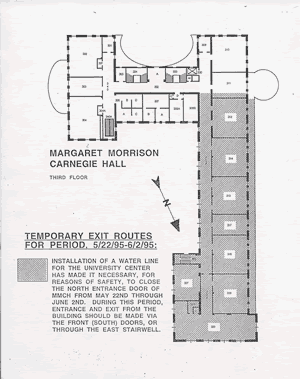|
Saturday, January 31, 2004
Summit Bound
The Design department provides all its graduate students with a small stipend to use to go to one conference per year. While others went to AIGA's Power of Design or are going to Vienna for CHI in April, this year, I'm taking my $350 and heading to ASIS&T's Information Architecture Summit, held in Austin on February 27-29.While I'm not overly interested in information architecture in the traditional, library-science sense (taxonomies, synonym rings, etc.), there is enough user experience and interaction design stuff there to keep me busy for three days. Hope to see some of you there!
posted at 11:45 PM in
cmu, field trips
| comments (2)
| trackback (0)
| link
miLife Extranet Launched
In order to keep Microsoft abreast of our activities on the miLife project, our newly-named team, Team XXXy (named to reflect our three women+one man composition), launched an extranet to post status reports, deliverables, etc.
posted at 11:26 PM in
projects
| comments (0)
| trackback (0)
| link
Wednesday, January 28, 2004
Small Map Redesign Project
Rob has done a good job with an overview of our Mapping & Diagramming class, so I'll just proceed on to talking about our first project.Back in 1995, CMU's Design building, Margaret Morrison Carnegie Hall (known simply as Margaret Morrison or MM here) had an exit closed for a few weeks during summer. CMU maintenance put up this map: 
Our class found roughly 30 things wrong with its design, some of which are pretty obvious, some not so. Stuff like the North on the directional arrow looks like a Z, for instance. Considering how complicated the map is compared to the information it wants to convey, it's pretty bad. My solution (pdf 24k) is a lot simpler: almost too simple, some would argue. But I think it's a hell of a lot clearer.
posted at 05:05 PM in
projects
| comments (0)
| trackback (0)
| link
Tuesday, January 27, 2004
Design Studies and Design Research
When I think of Design Research, I typically think of user research: observing users in order to build a product for them. But Design Research and its sibling Design Studies, aren't about that. Rather, they are looking at Design through other disciplines such as the social sciences in order to make Design knowledge available to other disciplines and to designers themselves.Design Research ("an activity in search of a definition" according to Susan Roth) is growing in importance and influence. There are three types: - Case-by_case. Looks at individual problems in order to gain insight into problems beyond the individual project. These are often case studies.
- Applied. Looks at groups of phenomenon to discover design principles. The Tufte books are examples of applied research.
- Theoretical. A rare form of research that tries to understand basic/first principles of a particular phenomenon. This research tries to put design problems into their broadest context.
According to Nigel Cross, Design resides in people, methods, processes, and products. Thus, Design researchers look at all of those things. Namely: - Epistemology: the study of how people design
- Praxiology: the study of the methods and processes designers use
- Phenomenology: the study of the products that are produced
Prototypes are a valuable resource for design researchers. Since there is typically little time to reflect and document during the late stages of product development, prototypes are often the only artifacts that researchers have about design thinking. And it is really design thinking they are often after, as a source and formal framework for solving problems. Design Studies is about interpreting and reflecting upon design activities, looking at them through the lenses of other disciplines. The purpose is to tease out insights, since Design is focused on production rather than knowledge per se. Jeff made the observation that Design Studies is to Design what Film Studies is to movies: a field of study that looks at the people, methods, and products of a group of creative professionals.
posted at 12:50 AM in
big ideas, design 101
| comments (0)
| trackback (0)
| link
Monday, January 26, 2004
miLife Concept Map
One of the initial deliverables for our Microsoft miLife project is a concept map of what our team feels are the big themes for the project. Those themes then, suggest areas of investigation for user research, which, in turn, suggest areas of opportunity for products. But first, there's the concept map (260k Flash), which, for fun (plus 40 hours of work), I made interactive. Enjoy.
posted at 09:03 PM in
projects
| comments (0)
| trackback (0)
| link
‹‹ preceding entries
|

